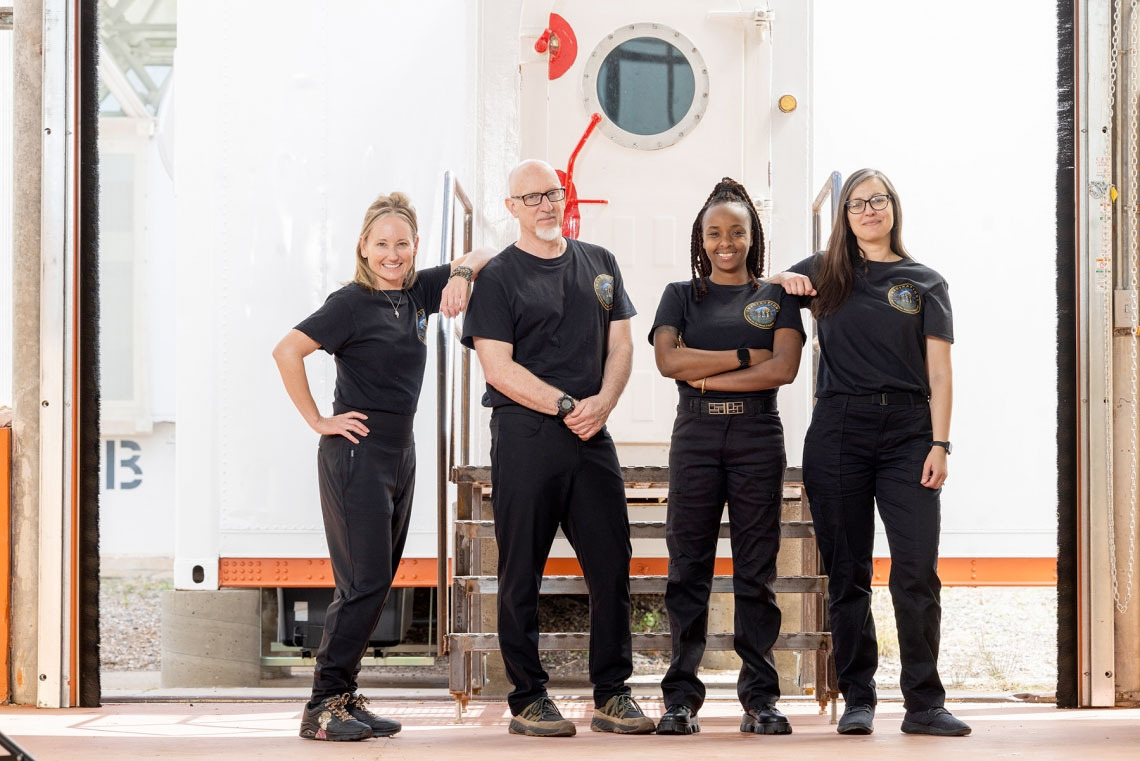iSchool Supports UArizona Crew of Artists as They Complete Simulated Moon Mission

The Imagination 1 crew, which includes a dancer/choreographer, nonfiction writer, textile artist and poet who is also an alumna of the iSchool's MLIS program, spent six days and five nights in a simulated moon mission. Photo by Chris Richards, courtesy University Communications.
Elizabeth George leaped into the air and lingered. When her feet finally touched down, she pushed up and spun three times before returning gently to Earth.
Such ballon—a term in dance meaning light-footedness—would normally be impossible on Earth, she said, especially while donning a roughly 20-pound, pressurized spacesuit.
Her near weightlessness was the product of engineering that allowed her to feel what it might be like to pirouette on the moon.
“Those first couple steps I took were just really magical,” said George, a dancer/choreographer and associate professor in the University of Arizona School of Dance. “They inspired a curiosity in how I could fully connect to that pocket of lightness accessible while executing a jump. It also inspired an interest in how a dancer’s perspective and connection to foot articulation and cross-body movement could potentially inform moving more efficiently in one sixth gravity.”
She and three other UArizona professional artists served as crew members in a six-day simulated moon mission, called Imagination 1. The goal was to explore the value of art in space exploration and produce creative works inspired by the limitations and possibilities of life and culture beyond Earth.
The crew was led by Christopher Cokinos, a nonfiction writer and professor emeritus of English, and also included Julie Swarstad Johnson, a poet, Poetry Center archivist and librarian, and 2020 graduate of the Master of Arts in Library and Information Science, and Ivy Wahome, a textile artist and Master of Fine Arts candidate in costume design and production at the School of Theatre, Film and Television.
“All of the art forms that we brought with us into this technological space are ultimately very human things,” Johnson said. “That's something I hope that we can convey to people as we think about any kind of movement beyond Earth. As humans, we're always going to be creating and thinking, and art can help us do that well.”
“To the moon with art,” Johnson said as she and the crew waved goodbye to family and friends from an airlock threshold.
Beyond that physical threshold held the interior to the Space Analog for the Moon and Mars, or SAM, a 1,100-square-foot pressurized and hermetically sealed facility that would be their home for the next six days and five nights. But in their minds, crossing that threshold meant traveling to the moon.
Within SAM, they covered the windows that would otherwise reveal the Sonoran Desert landscape, and the crew immersed themselves in lunar imagery with virtual reality headsets provided by the School of Information. By night, they projected images of the lunar surface, including the south pole region, an area of particular interest to humanity since the discovery of water ice, a valuable resource in space.
In addition to the immersive experience of the VR goggles, the crew also read poetry aloud about space travel and watched movies centered on the Apollo missions.

